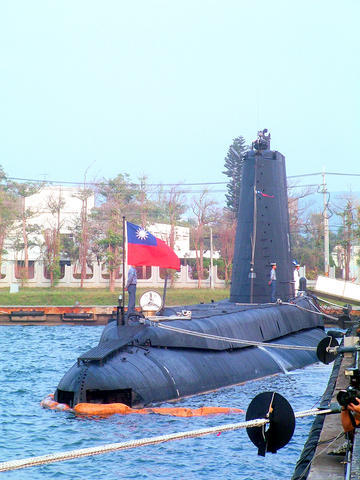The Navy celebrated the 63rd birthday of its oldest vessel -- the Guppy-class SS-791 Sea Lion submarine -- last Thursday.
The SS-791 was not only celebrating its 63rd birthday, but also its 34th year of service in the Navy. Along with the SS-792 Seal, the SS-791 is one of two existing "miracles" in the navy, as it is the oldest submarine still in service.
As part of the Mutual Defense Treaty between the US and the Republic of China (台美協防條約), in 1970 the US gave the SS-791 and SS-792 to the Taiwanese Navy -- after serving 28 years in the US Navy.

PHOTO: CNA
In 1973, Captain Kuan Chen-ching (
During the ceremony last Thursday, Rear Admiral Wang Hsi-ling (汪希苓), Taiwan's military attache to the US who oversaw the arrangement in the 1970s, officially accepted the two vessels on behalf of Taiwan.
With old piping, big knobs and rudders, old panels, limited space and the pervasive oil smell, the interior of the submarine is strikingly reminiscent of scenes from World War II movies. Sonars and torpedo systems complete the experience.
Among the 75 sailors on board, only the captain enjoys a private room -- and it is smaller than one ping. Everybody else, including the first officer, shares a public room for sleep. Regular meals are provided by a kitchen approximately two pings in size. It takes more than an hour for everybody on board to finish their meal as only 20 people can fit in the dining room at any given time.
With its 5,200 horsepower diesel engine, the SS-791 was initially capable of completing a non-stop 8,350km trip in approximately 45 days. Top speed under water was 12 knots and 16 knots on the surface.
A rumor that could have proven harmful to the navy's image and affect sailors' morale haunted the vessel since its acquisition, however. Some believed there was a real chance that after diving, the two Guppy-class subs would never resurface.
But SS-791 Warrant Officer Liu Tsai-hsin (劉財心) explained why the rumor never turned into reality.
"There is an air tank inside the vessel. When the submarine is on the surface, its entire weight is approximately 1,800 tonnes. When we need to dive, however, the air tank will take in 3,000 pounds [1,360kg] of air, turning the vessel into a 2,400-tonne rock. The system may be old, but it is reliable," Liu said.
Between 1944 and 1946, the US built 45 Tench-class submarines. Fourteen of those were upgraded to Guppy-class in 1950, including the SS-791.
Prior to joining the Taiwanese fleet, the SS-791 was known as the USS-478 Cutlass. It was built in the Portsmouth Naval Shipyard in Kittery, Main, and completed on Nov. 5, 1944.
The vessel was initially equipped with 10 torpedo launch tubes and sonar systems, with 11 officers and 70 petty officers and sailors.
But the US government's plan to help Taiwan's destroyer fleet conduct anti-submarine warfare resulted in the removal of all torpedo systems from the sub before it was handed over.
After it came into service, the Navy tried to restore its torpedo capability, but its indigenous system never reached optimal operability and the SS-791 was eventually allocated for training purposes.
The Navy's Fleet 256 chief of staff Rear Admiral Yang Yi (楊木益) believes the SS-791 can still make a contribution to the training of the Navy's next generation of officers.
"It is a tough environment for future naval officers to grow in. It is small, old and slow," Yang said. "But, the vessel itself is truly a legend."
Although it is the oldest submarine in service, many contemporary high-ranking naval officers have served on board the SS-791, including Minister of National Defense Lee Jye (李傑), Deputy General-Chief-of-Staff Admiral Wang Li-shen (王立申) and Deputy Commander-in-Chief of the Navy Lieutenant General Shen Po-chi (申伯之).
Lee was a lieutenant commander when the SS-791 was given to Taiwan and was also the first weapons chief on board the Sea Lion. He later became the third captain of the SS-791.
After new submarines are acquired by the Navy, the Ministry of National Defense will retire the SS-791 and the SS-792. Navy enthusiasts expect the two vessels will be restored after they retire and hope one will be used for training purposes at the Naval Academy while the other will be ported and turned into a museum.

A group of Taiwanese-American and Tibetan-American students at Harvard University on Saturday disrupted Chinese Ambassador to the US Xie Feng’s (謝鋒) speech at the school, accusing him of being responsible for numerous human rights violations. Four students — two Taiwanese Americans and two from Tibet — held up banners inside a conference hall where Xie was delivering a speech at the opening ceremony of the Harvard Kennedy School China Conference 2024. In a video clip provided by the Coalition of Students Resisting the CCP (Chinese Communist Party), Taiwanese-American Cosette Wu (吳亭樺) and Tibetan-American Tsering Yangchen are seen holding banners that together read:

UNAWARE: Many people sit for long hours every day and eat unhealthy foods, putting them at greater risk of developing one of the ‘three highs,’ an expert said More than 30 percent of adults aged 40 or older who underwent a government-funded health exam were unaware they had at least one of the “three highs” — high blood pressure, high blood lipids or high blood sugar, the Health Promotion Administration (HPA) said yesterday. Among adults aged 40 or older who said they did not have any of the “three highs” before taking the health exam, more than 30 percent were found to have at least one of them, Adult Preventive Health Examination Service data from 2022 showed. People with long-term medical conditions such as hypertension or diabetes usually do not

POLICE INVESTIGATING: A man said he quit his job as a nurse at Taipei Tzu Chi Hospital as he had been ‘disgusted’ by the behavior of his colleagues A man yesterday morning wrote online that he had witnessed nurses taking photographs and touching anesthetized patients inappropriately in Taipei Tzu Chi Hospital’s operating theaters. The man surnamed Huang (黃) wrote on the Professional Technology Temple bulletin board that during his six-month stint as a nurse at the hospital, he had seen nurses taking pictures of patients, including of their private parts, after they were anesthetized. Some nurses had also touched patients inappropriately and children were among those photographed, he said. Huang said this “disgusted” him “so much” that “he felt the need to reveal these unethical acts in the operating theater

Heat advisories were in effect for nine administrative regions yesterday afternoon as warm southwesterly winds pushed temperatures above 38°C in parts of southern Taiwan, the Central Weather Administration (CWA) said. As of 3:30pm yesterday, Tainan’s Yujing District (玉井) had recorded the day’s highest temperature of 39.7°C, though the measurement will not be included in Taiwan’s official heat records since Yujing is an automatic rather than manually operated weather station, the CWA said. Highs recorded in other areas were 38.7°C in Kaohsiung’s Neimen District (內門), 38.2°C in Chiayi City and 38.1°C in Pingtung’s Sandimen Township (三地門), CWA data showed. The spell of scorching